Securing Oklahoma’s Economic Future
By Bill Langdon
 The declining level of investment in our kid’s education and healthcare is having economic consequences for Oklahoma and threatening the economic future of our state. We no longer have a competitive, well trained and healthy workforce and are not attracting enough well paying jobs that can reverse the declining standard of living faced by the families in our state. Here are the statistics employers see when they consider locating in Oklahoma. We rank 32nd in the percentage of people in our state over 25 that have a high school education but only 42nd in terms of those who have a college degree or 30.8% compared with 34% for the nation as a whole. In addition, Oklahoma now ranks 47th in terms of the educational quality of its public schools as of 2017 and 46th in terms of overall medical health. These are two statistics that the state and local economic development professionals say is discouraging even average paying employers from coming to the state and completely shutting out employers who could provide the high paying jobs of the future. The declining level of investment in our kids assures that Oklahoma will be even less competitive in the future and that more of our families will be trapped in a cycle of poverty.
The declining level of investment in our kid’s education and healthcare is having economic consequences for Oklahoma and threatening the economic future of our state. We no longer have a competitive, well trained and healthy workforce and are not attracting enough well paying jobs that can reverse the declining standard of living faced by the families in our state. Here are the statistics employers see when they consider locating in Oklahoma. We rank 32nd in the percentage of people in our state over 25 that have a high school education but only 42nd in terms of those who have a college degree or 30.8% compared with 34% for the nation as a whole. In addition, Oklahoma now ranks 47th in terms of the educational quality of its public schools as of 2017 and 46th in terms of overall medical health. These are two statistics that the state and local economic development professionals say is discouraging even average paying employers from coming to the state and completely shutting out employers who could provide the high paying jobs of the future. The declining level of investment in our kids assures that Oklahoma will be even less competitive in the future and that more of our families will be trapped in a cycle of poverty.
We have done some things right in the past. Our technical school system is highly ranked and has been a model for the nation. Oklahoma is also currently one of only three states offering universal preschool. The preschool program recognizes the importance of early education, good nutrition and pediatric care in improving academic success. We have also developed a few community schools with education, nutrition and medical programs that can help provide a more level playing field for all our kids no matter the economic situation faced by their families. If we can develop nationally recognized programs for these areas of education across the state, there is no reason we cannot also have a statewide school system that ranks at the top and not the bottom as well as provide the nutritional programs and medical care our kids need to be able to learn and grow up healthy.
Some people say that taking care of basic needs of children is the responsibility of the parents and not the school’s or the state’s. But we all need to understand that it is in our own best interest to invest in our children and their futures if we are going to grow our economy. Recent studies by Sean Reardon at Stanford University have shown the gap in standardized test scores between affluent and low-income students in America has grown by about 40 percent since the 1960s, which tracks the trend of declining economic growth. Much of this gap in educational achievement has been caused by the growing inability of low-income families to feed their children enough nutritional food. The Federal Title 1 program was redesigned in 2010 to help low-income students do better academically by providing balanced school breakfasts and lunches either free or at a reduced cost. More than half of Oklahoma’s students participate in these programs. One in four of our students are also considered “food insecure” based on data developed by the Oklahoma Policy Institute. This means they come from families with incomes so low their parents cannot afford to provide adequate, nutritious meals each day and at times may go hungry. It is surprising to many people that so many students are food insecure in a state like Oklahoma where we have a strong work ethic and parents want to take care of their children. But almost all these parents who qualify for Title 1 are working. Only 5% of the families in Oklahoma with children eligible for free breakfasts and lunches have parents who are not working according to the National Center for Education Statistics. Most of the parents in this small group are either sick or disabled, lost a job and are looking for work or are incarcerated.
Somebody has to feed these kids and a lot of that responsibility if falling to the schools. As an example, 86% of Tulsa Public School students have qualified for Title 1 breakfasts and lunches. One of the schools in the TPS system where most people would never expect to find a large number of students who qualify for food assistance is Memorial HS where the number is 80%. This high school is in the middle of what was once considered a solid middle class neighborhood with a large park, golf course, hospital and major commercial buildings. It is a good example of how families have been squeezed by the decline in median real household income, which peaked in 1998 at just under $57,000 then dropped to below $52,000 by 2012. Data from the National Center for Children in Poverty in 2014 showed that families need an income of about $48,016, twice the federal poverty threshold, to meet their most basic needs. The median family income in Oklahoma for the last three years has been around $48,000, which means half the families fall below this minimum threshold.
This high level of student food insecurity poses a serious problem for the Oklahoma education system as it develops programs to raise the level of academic achievement in the state for all our students. If kids are hungry when they go to school, they have trouble concentrating and do not perform well in the classroom. Attendance is also an important factor in academic achievement. But the lack of good nutrition means these food insecure kids are sick more often and miss more days of school than students who get enough nutritious food. There is also a growing body of medical research that shows poor nutrition leads to slower brain development lowering a person’s ability to learn not just from the first few years after birth but continuing through adolescence. This means kids need adequate, nutritious meals through primary, middle and high school if they are going to have a chance to develop their God given potential and succeed in the classroom and in life.
Oklahoma’s public schools recognize how food insecurity affects their students’ performance and some have developed good nutrition programs. Many are also supplementing these by getting involved with our state’s two major food banks where the schools distribute food to their students to take home in the evenings and on weekends. Addressing the food insecurity faced by a quarter of our public school students will contribute significantly to improving the educational achievement of all our students regardless of income. Plus there are significant cost savings to the state’s taxpayers from making sure students have adequate and nutritious food from the time they are born through adolescence because they will earn more after they graduate and their healthcare and social welfare expenses will be reduced over their lifetimes.
In this article are a series of interviews with people who have dedicated their lives to improving the heath and education of our kids:
- Dr. Robert Block – Retired Chair of the Department of Pediatrics at the University of Oklahoma and Past President of the American Academy of Pediatrics.
- Dr. Jan Figart – Associate Director of the Community Services Counsel who has worked on programs establishing early education programs and the community schools.
- Karen Pittman – Retired TPS Elementary School Principal who developed nationally recognized programs for at risk schools and is currently head the Tulsa Dream Center’s after school program.
- Mark Modricin – Director of Charter and Partnerships Schools for TPS who has helped raise the performance standards for these public charter schools
- Lisa Griffin – Director of Nutrition for Union Public Schools who has developed innovative recipies with more vegetables and less salt and sugar, cooking programs for students and culinary programs for the schools cooks.
- Kit Hines – Director of Nutrition for Tulsa Public Schools who has also introduced more nutritious means and is working with the food bank to reach hungry children when they are not in school.
- Eileen Bradshaw – Executive Director of the Community Food Bank of Eastern Oklahoma who is working with schools to provide food insecure kids with nutritious food throughout the year
They have all developed successful programs that could be expanded throughout the state that would give Oklahoma the well educated and healthy workforce we need to be able to successfully compete for well paying jobs and secure our state’s economic future. There are many examples of other states that have seen a high return on investment from investing in their children and the resulting growth in their economies.
YPNG has developed Ten Policy Recommendations based on these interviews and other research on student achievement that are listed at the end of this article.
Part 1: The Benefits of Investing in Child Nutrition
Poor nutrition from birth through adolescence impairs normal brain development and affects a child’s ability to succeed in school. It can also cause many chronic health problems that will follow someone their entire life like diabetes and hypertension. In part 1 of our article, Dr. Robert Block talks about childhood nutrition and why public programs that address food insecurity and give children access to pediatric care produce a higher return on investment for Oklahoma’s taxpayers than having to try and repair the damage to their health when they become adults.
Dr. Block is well qualified to address these issues. He is a past president of the American Academy of Pediatrics (2011-2012) and only recently retired as a Professor of Pediatrics and Chair of the Department of Pediatrics at the University of Oklahoma School of Community Medicine in Tulsa. As a faculty member, Dr. Block won the Aesculapian teaching award three times, the Stanton L.Young Master Teacher Award, a University of Oklahoma Presidential Professorship, the Accreditation Council for Graduate Medical Education Parker J. Palmer “Courage to Teach” Award, the Ray Helfer Society Award in recognition of his work in the field of Child Abuse, and the Award for Outstanding Service to Maltreated Children by the American Academy of Pediatrics. He has been continuously named one of the “Best Doctors in America” since 2001 and the first Chair of the sub-board on Child Abuse Pediatrics of the American Board of Pediatrics from 2006-2009.
 All of us who are well fed have very little concept of what it is like to not have access to an adequate amount of nutritious food and the effect it can have on a child’s brain development and their ability to learn. Studies have shown that while nutrition has it largest impact on brain development from birth to around five, nutrition continues to have a consequential affect on brain development through adolescence. Physical changes in the structure of the brain affect everything a person does but particularly the ability to learn, which makes it important that children are well fed from birth through adolescence so their brain can fully develop and they can live up to their full potential.
All of us who are well fed have very little concept of what it is like to not have access to an adequate amount of nutritious food and the effect it can have on a child’s brain development and their ability to learn. Studies have shown that while nutrition has it largest impact on brain development from birth to around five, nutrition continues to have a consequential affect on brain development through adolescence. Physical changes in the structure of the brain affect everything a person does but particularly the ability to learn, which makes it important that children are well fed from birth through adolescence so their brain can fully develop and they can live up to their full potential.
The lack of adequate and nutritious food is a problem often faced by children in many families in Oklahoma. The level of income for a family of four just to get by has been shown to be twice the government’s definition of poverty and in the range of $48,000. Half of the kids in Oklahoma live in families who are at or below this level. You don’t have to go very far down this curve to find families that are really struggling with about one in four kids in Oklahoma considered food insecure. These children have to eat what is around them. Often there are few nutritious options and at times they may go hungry.
While it is logical that nutrition would be an issue in limiting brain development, new studies have also found that adverse childhood experiences (ACE) can cause stress that releases chemicals in the body that can limit brain development. Dr. Vince Felitti is a pediatrician in San Diego who did a study frequently cited as landmark research that looked at the prevalence and consequences of ACE. 18,000 adults who had health insurance coverage with Kaiser Permanente in San Diego were recruited for the study between 1995 and 1997 and have been in long-term follow up for health outcomes ever since. The study has demonstrated the association of adverse childhood experiences with health and social problems as an adult and came up with a list of ten stressors those adult patients had in their homes as children. Some were abuse issues, an absent parent and domestic violence. Emotional stress from food insecurity was a big ACE stressor. These ten stressors were shown to not just affect emotional development but also brain development particularly in the frontal cortex that does problem solving. Higher ACE scores in the children’s medical history meant they usually had more incidences of self-induced illnesses caused by smoking, alcoholism, drug abuse and overeating when they became adults, which made the cost of their medical care much higher than average. They also experienced a higher rate mental illness and incarceration.
You can see the lack of good nutrition and ACE stressors are two big strikes for children. I like to talk about them as each being one and half strikes. If kids have both an ecological strike and nutritional strike that is all the strikes they get and repairing the damage is very difficult when you are older. If you are going to intervene and prevent unfavorable outcomes, you have to do it early. While it may be difficult to change some family situations that create stress, you can get rid of one of these strikes by providing healthy food in early childhood and continuing that program through adolescence by providing school nutrition programs, SNAP and having food banks work with children. Eliminating this nutritional strike and the associated stress of food insecurity will positively affect a lot of children’s physical and emotional development.
While the schools can do a lot to help provide their students adequate amounts of nutritious food that will improve their health and academic performance, I know how even more effective these kinds of nutritional programs can be when the parents are also involved and the whole family is given access to nutritious food. Some people have argued with me that there are people taking advantage of food programs and that is probably true. There is always someone who is able to manipulate the system. But that percentage is small and is not a valid reason to not support these programs. I think we also need to continue to study kids who successfully transition out of these programs to better understand the things we are doing that are most effective in improving outcomes.
One argument I have heard when talking to people about the Title 1 breakfast and lunch programs is that if you put healthy food in front of a person, there is no guarantee they are going to eat it. This is the same issue if you bring a sack of groceries to a hungry family. I agree it doesn’t necessarily mean they are always going to eat everything. But most do and the benefit of these programs in improving a child’s academic performance has been well documented. Also food banks like The Community Food Bank of Eastern Oklahoma don’t just give out food. The type of food they distribute is based on sound evidence of what is needed for nutritional balance. So the programs that help feed children and families also teach healthy eating habits they will carry with them their entire life.
Part of my responsibility as a pediatrician is not just looking at the health consequences of nutrition but also the economic return on an investment in early childhood intervention. The best argument I know for persuading people to have the state and federal government invest early in childhood nutrition and learning programs is that it has been proven there are great economic gains for society. A lot of the data on the real economic returns from these kind of childhood investments has been developed by James J. Heckman, who is the Henry Schultz Distinguished Service Professor of Economics at the University of Chicago, a Nobel Memorial Prize winner in economics and an expert in the economics of human development. Rather than a moral argument, Heckman focuses on the economic value of equalizing educational opportunities and achievement in order to identify the most effective way to increase the productivity of the American economy. Here are two quotes from his work:
- “By nature and circumstance, endowments are unequal. At birth, each child inherits different capabilities and different resources to capitalize on them. We can’t completely change that picture. But we can change some of it. In particular, we should address the inequity in the resources families have to properly develop their children’s potential.”
- “We can invest early to close disparities and prevent achievement gaps or we can pay to remediate disparities when they are harder and more expensive to close. Either way we are going to pay. And we’ll have to do both for a while. But there is an important difference between the two approaches. Investing early allows us to shape the future. Investing later chains us to fixing the missed opportunities of the past”
In order to illustrate the economic returns from early intervention, he has developed what is called the Heckman Equation, which is my favorite equation because it involves no math. But it illustrates the higher return on the dollars invested early in a child’s development compared to after they are out of school and have become adults.
HECKMAN EQUASION
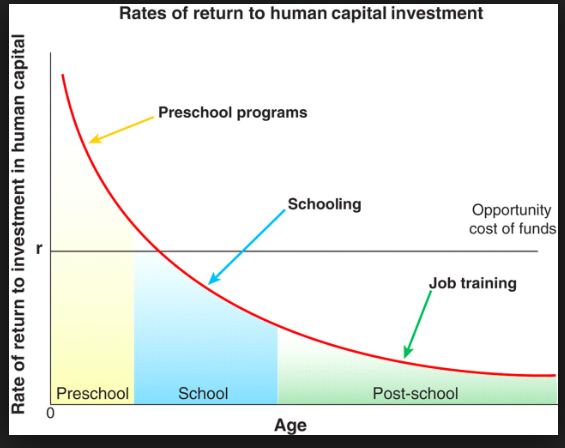
As examples of ways early investment saves money for society, it is easy to show that more and more of the medical related issues people from low income families are facing as adults like diabetes and hypertension could have been avoided if we intervened when they were children. Why would we bother? The amount the US spends on healthcare is rising in large part because we don’t spend enough money on food programs for children and they end up with expensive illnesses that we must treat for the rest of their lives. These people are also less productive members of society because we now know they have physiological changes in their brains that cannot be reversed. This makes it difficult for them to get job training or further their education, things that would make them more productive citizens and increase tax revenues. We can prevent many of these unfavorable outcomes when kids are able to get nutritious food in school through Title 1 breakfasts and lunches, through SNAP and through food banks. It also helps when pediatricians are able to see low-income kids because they are on a program like Medicaid.
Many people think using government money to provide food and medical care to low-income families is part of the nanny state and goes against values like self-reliance. But without these kinds of interventions, disadvantaged children are in fact going to be less self reliant as adults if they cannot learn because their brains have not fully developed and they have acquired chronic diseases in childhood because of poor nutrition, It is in everyone’s self interest to push to see these programs are well funded. Taxpayers will get a much larger return on the investment of their tax dollars spent on these childhood programs than having to deal with the consequences of lower levels of brain development among a large number of children that increases the expense of treating chronic diseases for a lifetime and makes these people less productive citizens.
To sum up, the knowledge pediatricians have gained over the past thirty years about nutrition and how it affects child development is significant. When I was teaching young pediatrician at the University of Oklahoma, we would go out and talk about childhood activity on wellness visits with parents because we knew then that was important. But because of this new knowledge base about the consequences of nutrition on brain development and other health issues, talking with parents about nutrition is now mandatory for pediatricians. If you support child and adolescent nutrition and medical programs, you have done something important that will make a difference for that person and everyone in Oklahoma.
Part 2: The High Return from Early Childhood Programs
Dr. Block talked about the positive effect nutrition programs can have on academic achievement and the fact that it is especially important to also make sure children receive adequate nutrition and medical care the first five years of their life before they enter the school system. Dr. Heckman’s economic studies quoted in the earlier interview with Dr. Block prove that providing quality medical care, good nutrition and early education during this period of a child’s life produces the highest return on investment for taxpayers. Inadequate investment in our youngest children leads to lower academic achievement, which translates into lower lifetime earnings and less tax revenue for the state. Furthermore, many will not earn enough to be self-sufficient as adults and will be forced into welfare programs for food and medical services throughout their lives. Low-income family members also have higher rates chronic illnesses, incarceration, addiction and mental illness. All of these things are an additional drain on our state’s financial resources.
Jan Figart is a leader in our community who has spent her life working on issues of childhood nutrition, medical care and early education who is currently the Associate Director and Senior Planner in Maternal and Child Health at the Community Service Council. Jan was previously with the Northeast Oklahoma Area Health Education Center and the Margaret Hudson Program that provides comprehensive academic and family support services to help teen mothers succeed and parent healthy families. She also provided leadership for the Tulsa Healthy Start Initiative as well as many other early childhood programs and has worked to provide medical services for the uninsured. Jan earned an associates degree from Tulsa Community College, a bachelors degree from Langston University, a masters degree in nursing from the University of Oklahoma and a doctorate in health administration from the University of Phoenix. Among her many awards are the Nursing Impact on Public Policy Award presented to her by the Oklahoma Nurses Association and a Humanitarian Award from the American Red Cross.
One of the important things she points out in her interview is that Colorado and North Carolina began making investments in education, health care and nutrition programs for their children in 1975, a time when they had similar demographics to Oklahoma. The improvements in the quality of their workforce that resulted from greater investments in their children helped attract new businesses that provided higher paying jobs, more state tax revenue and raised the quality of life rankings for both states.
This high return from investment in their young people is in sharp contrast to the negative results achieved from economic policies followed by states like Louisiana, Kansas and Oklahoma that aggressively cut taxes the past few years without large cuts in services expecting to incentivize new business formation and expansion and generate new tax revenue. That did not happen. At the end of Jan’s article are quotes both a former state treasurer and an OSU economist who predicted these changes would lead to a structural budget deficit and greater income inequality for our state. So instead of increasing economic activity, these tax reductions reduced state revenue and the money going to education and children’s programs. This lack of investment in young people has ended up lowering rather than raising wage growth in these states in large part because of the declining quality of the workforce. These examples demonstrate that young people are Oklahoma’s greatest asset and investing in them so our workforce can compete in the modern economy is a proven way for Oklahoma to build a sustainable economic future. Here is Jan’s interview:
 Oklahoma took a downward turn in the 1970’s and the economy has never fully recovered, especially for people with only a high school education and those who did not graduate high school. These people have seen their standard of living decline, which in turn has put more pressure on the healthcare and nutrition programs they need from local, state and federal governments just to survive. Declining wages for so many people in Oklahoma has been due to our own poor choices. We have simply not invested in our children’s education or the nutritional programs and health care they need that would allow them to break the cycle of poverty beginning when they are born and continuing through adolescence. Because of this lack of investment, Oklahoma now falls into the bottom four in terms of every measure relating to health issues.
Oklahoma took a downward turn in the 1970’s and the economy has never fully recovered, especially for people with only a high school education and those who did not graduate high school. These people have seen their standard of living decline, which in turn has put more pressure on the healthcare and nutrition programs they need from local, state and federal governments just to survive. Declining wages for so many people in Oklahoma has been due to our own poor choices. We have simply not invested in our children’s education or the nutritional programs and health care they need that would allow them to break the cycle of poverty beginning when they are born and continuing through adolescence. Because of this lack of investment, Oklahoma now falls into the bottom four in terms of every measure relating to health issues.
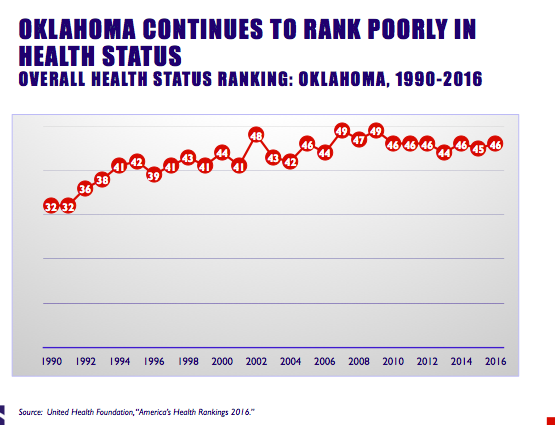
This lack of investment in our children’s health and education has had economic consequences for Oklahoma. 41% of the people in our state over 25 only have a high school education or did not graduate from high school. Only 35% have a college degree. This limits our state’s ability to attract new businesses because of the shortage of well educated workers and professionals like engineers.
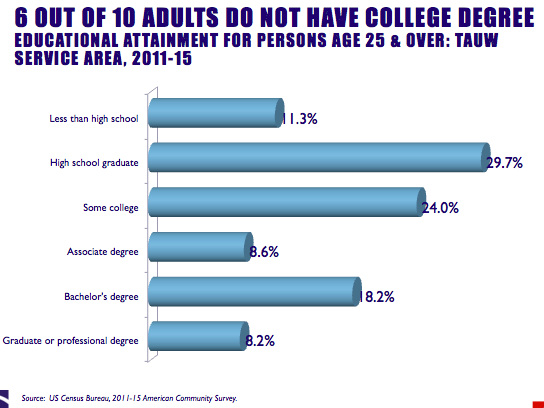
This large group of people with only a high school education or less has seen their wages decrease on an inflation-adjusted basis since 1973. Only college and advanced degree holders had an increase in their real wages over this time frame.
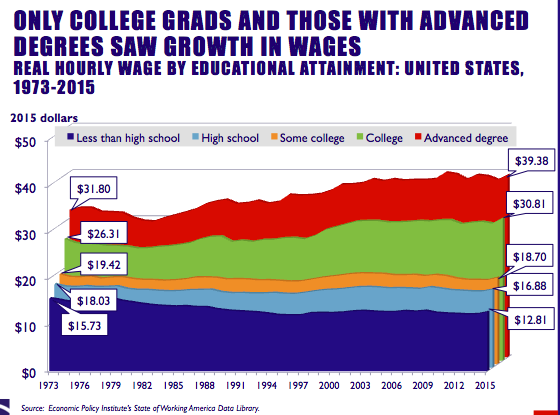
By not investing in education and health care for our children, Oklahoma has increased the number of low-income people as a percentage of the population. The additional cuts facing programs that would allow people to earn more makes the situation worse because our state will be even less competitive as the quality of our workforce continues to decline. This in turn will increase the number of people who are dependent on public and private welfare programs for their basic needs. The low percentage of people getting advanced training and going to college after high school also decreases their access to health care because people with only a high school education or who have not graduated are usually working in jobs that do not provide health insurance. Their lack of private health insurance means most of the expense for their medical services will have to be absorbed by hospital emergency rooms and state and federal programs because they do not earn enough to afford to pay for health insurance on their own.
If we are going to break the cycle of poverty and raise the standard of living in our state, it is important to understand that the large number of people on welfare in Oklahoma is a problem caused by the high proportion of low wage jobs in the state and not a lack of our people’s willingness to work. The statistics show that almost everyone receiving welfare benefits or charity from food banks and churches is working. They are simply not earning enough at their jobs to be considered “Self Sufficient” even though they may be above the federal poverty level (FPL). The Self Sufficiency standard is a more sensitive measurement of the level of earnings a family must have to not need any public and private support than the FPL and is based on family composition, family income and geography. The self-sufficiency income level in Tulsa County ranges from 184% to 244% of the FPL depending on family size. But because low-income families on average have more children than higher income families, a greater percentage of children in the state are at risk of poverty than adults. Rates again vary by county. But for the overall area served by CMS and the Tulsa Area United Way (TAUW), 51% of young children live below 200% of the FPL and 25.5% below the FPL. Only about 5% of these children are living in families where at least one parent is not working and most of these parents are disabled, incarcerated or looking for work.
We find our state in a declining economic spiral because we have had public policy in Oklahoma that says we do not want to invest in health care for low-income children or public education with only a few exceptions. Instead we have said that the government should not be involved in the general welfare of our state’s children. Added to the lack of political will to invest in childhood health services and public education, we now have an overlay of inadequate state revenues that is reducing children’s programs even further and the possibility of new federal budget cuts to these program. Unless this trend of underinvestment in our children is reversed, the result will be a further reduction in the standard of living in Oklahoman as the quality of our workforce declines and more people become dependent on government and private charities for food and medical services just to survive.
In order to improve the overall health of our children, we must understand that it is important that our schools teach more than just the 3 Rs and that we educate our kids about health issues. We are the last state in the US that has not embraced health education in the public schools and does not teach basic principles of hygiene, nutrition, health care and disease prevention. Even Mississippi has adopted this program in their schools. Because we never adequately addressed issues of nutrition and healthcare when our children’s parents were growing up and attending our public schools, the health outcomes of this next generation will likely be worse than their parents. It will take adequate investment in children’s medical care along with providing all disadvantaged kids better nutrition and educational opportunities from birth through high school for at least two generations to fully break this cycle.
Colorado and North Caroline had demographics similar to Oklahoma’s in 1975 and made a decision then to improve their education and health care systems and have seen the benefits from investing in their children. Colorado is now one of the healthiest states and is ranked number 11 by US News and World Report for 2017 and North Carolina at 27 has also done much better compared to Oklahoma, which is at 48. Besides programs that improved nutrition and medical care for children, these two states made health a part of their comprehensive public school education just like math and English. Health education in Oklahoma is basically an instructional block in third grade and mandatory AIDS education in middle or high school. We also do not teach human physiology in high school. Any physiology is elective and most schools will not teach reproductive health.
If parents do not appreciate the value of nutrition and health care and our students do not have an education that will allow them to get a job that will sustain them and their children, these people will be forced to move to public welfare programs that were meant to be temporary. They will have to remain on these programs their entire lives because they simply make less than they need to afford an adequate amount of healthy food and medical care. Fortunately, many programs exist to help fill the gap between what these families can afford and what they need to survive. A quarter of TAUW service area residents, 242,206 people, received medical benefits from SoonerCare in FY2016. Nearly four out of ten of Tulsa County’s infants receive WIC benefits, and 200,000 residents receive SNAP (formerly Food Stamps). Over half of the county’s public school students participate in the free lunch program, and an additional 9% qualify for reduced price lunches. So you can see that many Tulsa County families, children, and individuals rely on public assistance programs to meet their basic needs.
Added to this problem, you have parents who do not know how to make healthy choices with the limited amount of money they have starting from the time their children are newborn until the time their children have access to nutritious food at school. Consequently, kids from these low-income families are deprived the opportunity to get the nutrition they need when their brains and bodies are developing rapidly. Slower brain development due to the lack of good nutrition means it is more difficult for them to learn. So it all feeds into this huge loop: inadequate education of the parents means these people earn less and cannot afford enough nutritious food, inadequate nutrition for their children reduces the child’s academic ability because of impaired brain development. It also causes a high incidence of diseases like diabetes in children. These and other stressors faced by children growing up in low-income families cause high incidences of early death and high rates of incarceration and addiction. All these things create more costs for the state that could have been avoided if money had been spent when these people were children. They would have been smarter, gotten better jobs and generated more tax revenue rather than consuming social services and tax dollars.
Even though there is plenty of evidence of the benefit of early childhood programs, government is providing less not more support to young children and this is having serious consequences. A good example is the Women, Infants and Children Program or WIC. Five years ago the funding to WIC was reduced. So women got less formula for their newborns during the first twelve months and regulations were changed with fewer women qualified for WIC. Mixing formula correctly is 20 calories for each ounce of water. But if the mother gets less formula than she needs and this is all she has to feed her baby, the child is going to get skinny and will be labeled by DHS as being in an environment where there is a “failure to thrive.” This means the baby is at risk of being taken away from the mother. Plus that baby is going to cry all night because it is not getting proper nutrition and its brain is not going to fully develop because of the lack of protein. So what we have seen is that mothers recognize the need to keep the calories up if they want to keep their babies and are using soda instead of water to mix with the formula. The child then gets more calories from the sugar but less nutritional value than if they had adequate amounts of formula but the baby doesn’t get skinny and sleeps. The result is that we now have children with “protein energy malnutrition” that is leading to cognitive impairment. So we are dumbing down a generation of low-income kids because their families cannot afford the food their children need.
Early childhood learning is also a proven determinant of long-term academic success and is one area where Oklahoma is a national leader. School districts in our TAUW area have made great strides in providing and enrolling four year olds in pre-K programs. Over 8,000 four year olds are enrolled in full-day programs and almost 700 in half-day public pre-k in our 6 counties. We have shown that children who attend pre-kindergarten benefit from better vocabulary scores, improved attendance and have higher high school graduation rates. Research on the long-term benefits of pre-kindergarten suggest that children who attend pre-kindergarten are also more likely to avoid criminal behavior, be more resilient, have increased earnings and better overall health.
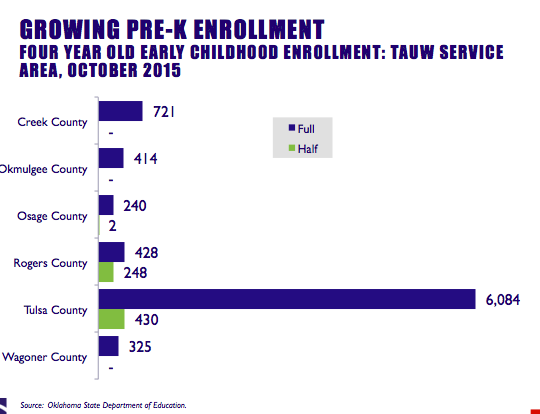
CSC has worked on the premise that preschool education is a voluntary choice for parents until kindergarten as well as to have their children involved in care outside of the home even when they know there is a licensed childcare program they can access. When we examined this we found that only about 60% of families participate and that the biggest thing driving the participation figure is the cost. We also found the parent had no real way to gauge the quality of a childcare center. So we worked in collaboration with the Department of Human Services to set up a three star system to help parents make better choices for their children and have tried to get all the centers to become a three star. We now have some of the highest ranked childcare centers in the US. Oklahoma was able to do this because it was proven to the legislators and private donors that if you invest in high quality child care and pre-school education, you have fewer children who later drop out of school and fewer teen pregnancies. More people also go on to college and enter technical training programs. But recently fewer kids are able to go to three star childcare centers because the cost to the parents has gone up as funding has been reduced.
The private sector has recognized this need and has set up some effective programs that provide early education and healthcare. One that was introduced in Tulsa for early childhood is Educare by the George Kaiser Family Foundation. They makes a total investment in the child of more than twice the investment of private child care. But only 600 children in Tulsa can participate. The program involves food, childcare, education and parent training. It has produced great results but it is not scalable throughout the state because of the expense. As an alternative, CSC is focusing on parent support for newborns through the age of 3. Working individually with parents, grandparents and other family member who provide childcare is not as effective as we would like because we do not have enough professionals to work with all the parents who could benefit. But right now this limited program is the best alternative we have.
While there are a lot of successful early childhood programs sponsored by private donors, we cannot go about correcting this problem of inadequate nutrition and preschool education for newborns to five year olds in our state through a patchwork of small programs. A thousand of these programs, no matter how good they are, will not fix the problem across the entire state. There has got to be a change in the will of the citizens of Oklahoma so we send people to the legislature who will deal with these issues if we are going to build a sustainable economy for the long term. A growing economy requires you have healthy children who are being prepared for the jobs of the future by a state that spends more time focusing on statewide policy that will have a positive effect on all its children rather than relying on patches from private programs that can only affect a small percentage. Getting government to invest and understand this bigger picture is important if we are going to make the changes Colorado and North Carolina did that will sustain our own state’s economic future.
So the outlook right now is not good. The poor have gotten poorer. Food insecurity is getting worse. Healthcare is getting worse. Educational opportunities are getting worse. We spend about $19,000 per person to put someone in jail and our state incarceration rates are high. We are number one in the world per captia in our incarceration rates for women and fourth in the US for men. Our overall health rankings are in the bottom four with our population having high rates of chronic diseases that are expensive to treat like diabetes and heart disease. All these trends could be reversed like they did in Colorado and North Carolina with a sustained investment in our children. But this will require the state to solve its chronic revenue problem so it can make greater investments in our children’s health and education.
Tax proposals and state budget studies were presented at the 2015 Oklahoma Academy Town Hall (OATH) that accurately predicted our ongoing revenue shortfalls and gave some of the reasons the sharp reduction in the income tax rate and the minimum income subject to this tax did not increase economic activity in the state and raise wages but rather increased poverty:
Kent Olsson, PhD and Professor of Economics Emeritus at OSU, predicted in a paper for the 2015 OATH that the state would face an increasing structural budget deficit from the scheduled reductions in the top bracket personal income tax rate and the minimum income subject to that rate and said that these kinds of income tax reductions were a recipe for greater income inequality that could lower Oklahoma’s economic growth:
“The impact (of the changes in tax rates and minimum income to which they apply) greatly reduces the “fairness” of the tax and increases income inequality. Increasing income inequality may well be a recipe for slower economic growth, rather than the faster growth hoped for by tax cut proponents. Thus, if Oklahomans want tax reform that provides adequate revenue, and promotes fairness and economic growth, they should be exploring ways to increase income tax revenues.”
At the same meeting, Scott Meacham, a former Oklahoma State Treasurer, also commented on the failure of reductions in tax rates to stimulate economic growth when applied at the state level:
“Income tax opponents like to make the argument that a reduction in personal income tax rates results in a corresponding greater increase in state revenues as tax savings are spent and invested in the state and economic activity multipliers apply to those expenditures. However, that premise holds up much better in a national, macro-economic environment than it does at the state level. At the state level, if state government reduces income taxes, federal taxes increase and spending of any net tax savings is as likely to occur outside of Oklahoma as in Oklahoma. On the other hand, by definition, 100% percent of state expenditures must be spent in the state with economic multipliers applying to those dollars.”
So as we have seen in Oklahoma as well as Kansas and Louisiana where the politicians argued that reducing taxes would stimulate economic growth, the short term affect has not increased growth rates. It has only reduced revenue and caused the states to make reductions in money spent on education and programs that could improve people’s health. All these program reductions have made these states less desirable for employers. This outcome is in sharp contrast to the examples of Colorado and North Carolina where sustained investment in children has led to economic growth and a better quality of life for all their citizens.
Part 3: How Community Schools Improve Educational Outcomes for Children from Low Income Families
Jan Figart documented the trend of declining incomes for the majority of families in Oklahoma. That decline was shown to be the result of our workforce not being as well educated and in poorer health than people in other states, which makes it difficult for Oklahoma to attract businesses with higher paying jobs. Unless we reverse this trend, we will see a further decline in Oklahoma’s standard of living. We know what needs to be done. The higher incomes and growing tax revenues shown by those states that made sustained investments in their children’s education, nutrition and pediatric care provide proof of the high return Oklahoma can expect if we choose to invest in education. But to maximize the return on investment in our children, we must also look for ways to make our public schools more relevant for our students so they stay engaged and graduate from high school career or college ready. This is particularly true for schools serving children in low-income neighborhoods where the lack of good nutrition and medical care handicap their ability to learn and reach their full potential as adults. One of the best ways to do this is to provide these children with the opportunity to attend community schools.
The National Institute for Educational Leadership defines community schools as a set of partnerships that integrate academics, health and social services, community development and community engagement. Community schools are intended to become centers of the community and are open to everyone every day and on evenings and weekends. Children going to community schools students have been shown to attend school consistently and families become more involved with their children’s education.
In 2007, the Community Services Counsel of greater Tulsa, which is funded by the Schusterman Family Foundation, hired Jan Creveling to identify an education improvement strategy appropriate for Tulsa. The CSC determined that community schools offered a better framework than all the other programs under consideration. CSC then formed the Tulsa Area Community Schools Initiative in 2007 to develop community schools in the Tulsa area. TACSI engaged the entire community in a series of family, school and community partnerships to promote successful learning for children from low-income families.
TACSI schools focus on seven core components:
- Early care and learning
- Health/health education
- Mental health/social services
- Youth development/out-of-school time
- Family/community engagement
- Neighborhood development
- Lifelong learning
There are currently 18 community schools in the Tulsa area and every Title I elementary school in the Union School District is a community school. Union’s community schools incorporated the principals of nutrition, pediatric care and pre-school that Dr. Block and Jan Figart have shown are so important for educational achievement. In this way, they promote learning but also take care of the all the student’s needs whether that is nutritional, social or emotional.
Union’s community schools put an emphasis on early childhood development before their kids even enter kindergarten. Union starts their early childhood program at age 3 and has a partnership with Tulsa’s Community Action Program designed to give these kids a full day with instructors. Their early learning programs are run the year round to help them get jump started for pre K.
Union’s community schools also have school-based clinics that serve as the primary medical home for 4 thousand people in East Tulsa. People who use these clinics may not even be in the Union district but the school is simply the closest Medicaid clinic. The University of Oklahoma staffs the clinics with doctors and Physician Assistants in space provided by the school. There are also about 40 licensed LPCs from Family and Children’s services that can be called on to provide mental health support.
Unions community schools also have amazing after school programs like yoga, tai chi, art, academic engagement, soccer club, dance and many other things. These classes are part of an effort to extend learning opportunities as late as possible and throughout the summer so that students can fill in the gaps as an English language learner or a child living in poverty and to engage the parents with their children. Below is a picture with Union’s superintendent, Dr. Hartzler, with some students in front of a community school clinic and a picture of parents and their children together in a program at a Union community school.
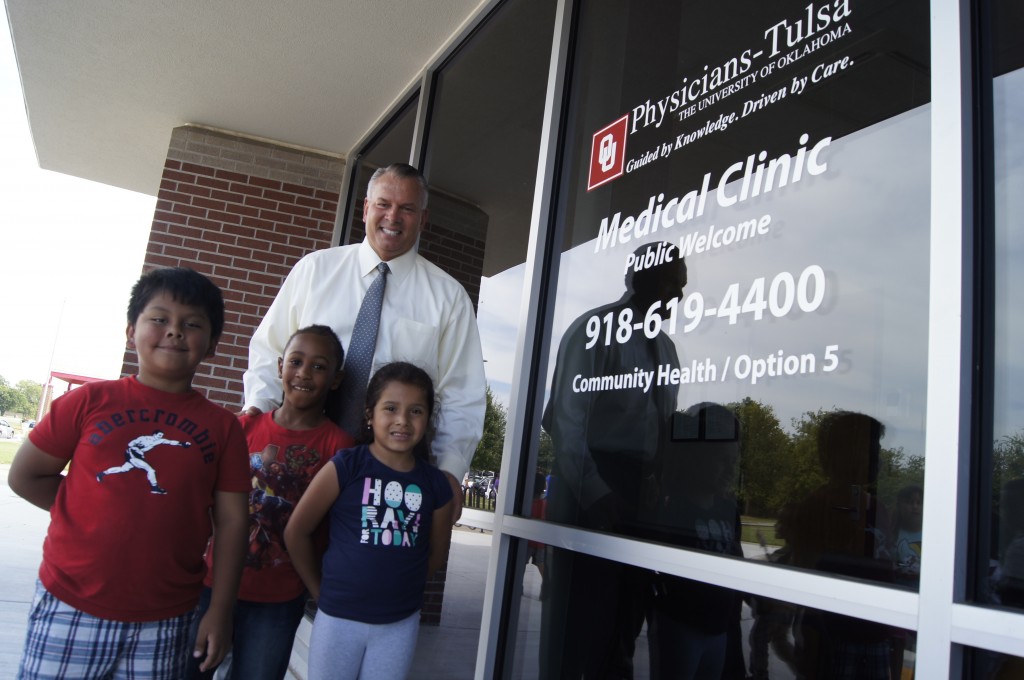
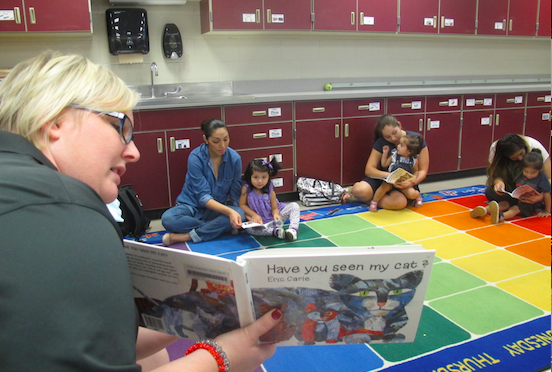
Part 4: Strategies for Improving Results in Our Public Schools
In this interview, Karen Pittman discusses what she did to turn around low performing and at risk schools in the Tulsa Public Schools system. Karen was so successful improving test scores that her school received national recognition. But these kinds of innovative processes that will improve the performance of low performing schools are only possible if there is adequate school funding in Oklahoma. Today’s funding levels compared to when Ms. Pittman developed her processes means class sizes are now too large for teachers to effectively employ these teaching strategies. This means we need to not only pay teachers more so we can attract and retain high quality and experienced professionals, we also must hire more teachers so Oklahoma can reduce class sizes especially in elementary schools. Smaller class sizes will allow us to be able to use the kind of data driven teaching methods that have been proven effective in raising student performance and creating a level playing field for kids from all income groups and geographical areas of the state.
Karen grew up in Tulsa and is a graduate of Booker T. Washington HS. She went on to the University of Central Oklahoma where she received her Bachelors of Education. She taught kindergarten through grades six for twenty-three years before receiving a Masters Degree in Educational Leadership from OSU Tulsa and moving into school administration. Ms. Pittman first did a one-year principal internship at William Penn Elementary School before she became an instructional specialist and was assigned to eighteen of the lowest performing schools in TPS district. Karen led professional development programs for teachers at these schools and brought in new instructional strategies that were data driven based on weekly testing. She later worked for one year as an assistant principal at Cooper Elementary. She then became principal at Academy Central Elementary and remained there for four years before retiring. After her retirement from TPS, Ms. Pittman became a Senior Consultant for Focus on Results, a national company headquartered in California that goes into struggling schools and helps them create a framework for leading improvement by identifying and implementing a school wide instructional focus. She worked for two years in the Los Angeles County School system and then one year in the St. Louis Public Schools while employed with Focus on Results. In 2016, she took a position with the nonprofit Tulsa Dream Center, where she is the Director of their after school educational programs. These programs have been highly successful. Before the Dream Center began serving this area of Tulsa, 68% of the children were unable to pass their mandatory third grade reading tests. Students who participate in their programs now have a 97% success rate.
 I became involved with Academy Central Elementary in 2009, a school that was designed to begin to prepare kids for college. Despite its goal of setting high standards for its students, Academy Central was near the bottom in terms of the academic achievement of its students. I brought in a process developed by the company Focus on Results in January and we doubled the student’s test scores by the end of that school year. People from across the country were coming to our school to see what we were doing. “Tulsa’s Best Kept Secret” is a documentary that talks about the strategies we used: https://www.youtube.com/watch?v=1u51D0NBSd0.
I became involved with Academy Central Elementary in 2009, a school that was designed to begin to prepare kids for college. Despite its goal of setting high standards for its students, Academy Central was near the bottom in terms of the academic achievement of its students. I brought in a process developed by the company Focus on Results in January and we doubled the student’s test scores by the end of that school year. People from across the country were coming to our school to see what we were doing. “Tulsa’s Best Kept Secret” is a documentary that talks about the strategies we used: https://www.youtube.com/watch?v=1u51D0NBSd0.
The word “focus” for us meant that all the teachers at our school from pre K through grade six were using the same teaching methods to teach reading, reading comprehension and building academic vocabulary. It is well documented that improvement in these three areas translates into improvement in student performance in all the other subject areas as well. These programs were data driven based on information we collected from benchmark and state assessments. Teachers and students were given notebooks with this data so they could track their progress. Once a week we critically examined the data for all of our students with the teachers and displayed the student data and school wide goals on the walls of the classroom and in our data room to help the teachers and students stay focused on their goals.We also had a leadership team that met weekly with teachers and professional development programs that were part of our weekly faculty meetings where new teaching strategies were introduced and I did regular classroom visits to observe the students and teachers. Our teachers were also given opportunities to collaborate with other faculty and administrators at the school to improve teaching and learning for all stidents as well as with teachers and administrators from other schools who came to observe what we were doing that was producing such large increases in our national test scores.
Academy Central is also what is called a community school. These schools integrate their focus on academics with health and social services and work on ways to engage with the community. As part of this goal, we always tried to involve the parents. We made them aware of what their children were doing and invited the parents to the school to see our programs and talk to the teachers. More and more parents came as they saw the change in their children and wanted to talk with the teachers about how they could help them. But our focus program was dropped after only two years despite being so successful because of the lack of funding.In my opinion, Oklahoma has missed the boat when it comes to education not just because of the present funding problems but also because there is not much equity between schools under the current funding system. You can see that in the condition of different schools in the state and the difference in turnover among teachers and principals at individual schools. One school has teachers who stay for twenty years while another school has teachers who only stay for a few years. Classroom experience is important to be an effective teacher especially when working with at risk students in elementary schools and teacher continuity is important to these young children. There is also a wide disparity among schools in terms of the kinds of technology and materials available to their students. One school provides up to date technology while in another the children have little to work with and teachers sometimes buy teaching materials with their own money.
Oklahoma needs to level the playing field for our schools regardless of the income level of the students’ families if we are going to develop the potential of all the children in our state. Under the current system, the state sends money to a district but not to individual schools. Budget analysts for the school district used to be employed and assigned to each principal. But these positions have been reduced or eliminated and schools have had to go to site based budgeting. Site based budgeting puts the responsibility on a school principal who may not have a good understanding of the budgeting process and what must be documented to get a school’s full allocation of funding compared to an experienced budget analyst. Plus the high turnover among principals at some schools means they don’t have time to gain enough experience with the financial requirements for a particular school to be able to do a good job budgeting.
There is also a nutrition problem faced by students in low-income school districts because the kids do not have access to enough high quality food and this affects their ability to learn. There are a lot of different factors that can cause this. Parents may not have adequate transportation to get to a good grocery store if they live in an area that does not have one, something we now are calling living in a food desert. If the family is poor, the parents may have to buy a lot of foods that are higin carbohydrates like beans and rice to make things stretch. So their kids do not get enough fresh fruit and vegetables and high quality protein and their physical and mental development suffers. Kids are also able to focus better on their studies when they are not hungry and don’t haveto worry about eating. When I was teaching, I always had some food in my desk like energy bars for students who came in late and may have missed breakfast. At the Dream Center, we feed all our kids a hot meal before we even begin teaching a class. I know from my own classroom experience that nutrition has a direct correlation with learning. Having a good food program is something that should be part of any school because so many children in Oklahoma are from low-income families and do not have nutritious diets or get enough food.
Inadequate medical care for students in low-income school districts also leads to higher absenteeism and lower academic performance. We have a clinic at the Dream Center for our students where we also can keep track of the health of our kids. Just like some of the clinics in the community schools in the Union District, low-income students can get access to many of the prescription drugs they might need but may have trouble affording. Access to affordable medial care is a big issue and something that should also be addressed if we want to level the playing field for all our students in Oklahoma regardless of their family’s income.
Here is a list of what I would do to improve Oklahoma’s schools:
- We need to not just focus on trying to increase pay so we can attract and retain good teachers, we must also increase funding so we can increase the number of teachers and reduce class size. An elementary school teacher cannot be effective with more than 15 to 18 in a classroom. We are now at almost 30 in TPS. There is poor interaction between the kids and the teachers and little individual instruction with these oversized classes.
- Currently we use bond issues for upgrades and renovations of our schools. Most of these bonds issues do not raise enough money in low-income districts and take too long. I know of older schools where kids and teachers are getting sick because of mold. These buildings should have been replaced or at least renovated many years ago.
- Each school should be funded to include social workers as part of the community school concept. (Union has done this as part of their strategic plan to increase graduation rates and has seen good results.) There are just too many problems taking place in today’s society and many kids need this kind of help.
- I believe it is important to have music and art along with PE at every school. Kids have so many special talents and we need to tap into them. If we don’t give students other opportunities than just academics, kids don’t stay engaged. They need to be allowed to do things that interest them and have opportunities to be creative so they grow as individuals.
- I would do away with letter grades because an A in one school is not the same as at another. You can see this is true because too many kids who get good grades in high school and go on to college have to take remedial classes. A better way to measure academic achievement in my opinion would be a quality number system that is based on some form of uniform testing or rubric.
- You want to teach students to be successful at life and not just in academics. One way to help them learn the skills they need is to give them problem solving tasks that show the importance of how what they are learning in school translate to real life experiences. For example, when we teach math we can show kids everyday ways to use the math like having them construct a model bridge or building. By using real life examples, kids see how what they are studying is going to benefit them in the future. Schools should also provide cooperative learning opportunities where students solve problems with other students so they learn how to work in groups.
- Technology is going to affect most every job in the future. I would like to see all schools start teaching STEM classes by third grade. I would also make sure students have enough computers and instruction on how to use the latest computer technology
- We need to support a level of public funding for education where we can invest in a quality staff. If your school is struggling you do not want new teachers, you want teachers who know the subject matter and know how to work with low performing and at risk students.
- There are a lot of vending companies selling academic programs. Rather than using vending companies that are promising performance improvement, my experience has shown me that if schools gather the data on each individual student like we did at Academy Central, they will improve a student’s academic performance. This research based approach focuses on monitoring the progress of each student and giving them what they need to succeed. When you follow this approach, you have to stick to it for at least five years to train a full staff and let the program filter through the school.
- An alarming percentage of women in Oklahoma are incarcerated for nonviolent crimes. (This statistic is the highest in the US). When a woman is put in jail, it is expensive for the state not just in terms of the cost of incarceration but also because removing a mother and income earner from her children’s home increases the cost of social services for those children. There have been a number of alternatives to incarceration proposed to deal with nonviolent offenders that will help keep more families together, which will improve the educational outcomes for many students and reduce costs for the state.
Part 5: Oklahoma’s Public Charter Schools
Overview
Public charter schools were first started in Minnesota in 1991 to encourage innovation in public education by giving charters the freedom to develop their own curriculums and teaching methods.Public charter schools are also meant to be a way to allow students to have more choices about their education than in a regular public school system. For example, students can choose a charter school with a curriculum that concentrates on preparing them for college or a school with a more disciplined environment.
While there are a limited number of seats available in any charter school, there are no admission tests like there are for magnet schools. Anyone can apply. If more students apply than there are seats, admission is by a lottery. But this means there can be waiting lists for the most popular and effective charter schools.
Public charter schools are funded by the state under a formula that is similar to other public schools with two exceptions. In Oklahoma, the Authorizer that oversees the school is able to take a fee of up to 5% of the funding provided by the state to cover the cost of supervising a charter school and holding them accountable for meeting various performance standards. Another difference is that a charter school cannot issue bonds. Consequently, they usually lease rather than own school buildings.
Charter schools now represent about 5% of the public schools in the US. But the results from charter school expansion are not consistent across the country. Only about one third are performing better than public schools in their districts, twenty percent are performing below the level of regular public schools and half at the same level according to recent studies by Stanford University. Oklahoma’s results as reported by the Department of Education show similar performance percentages for charters across the state compared to regular public schools. This inconsistent performance means that funding the expansion of charter schools can be controversial in many states and school districts.
How Public Charter Schools Operate in Oklahoma
 We interviewed Mark Modrcin, the Director of Charter and Partnership Schools for Tulsa Public Schools, to give you a better understanding of how public charter schools operate in Oklahoma and how TPS collaborates with its charter schools. Mark heads both the Authorizing Office and the Tulsa Charter Collaboration Compact at TPS. Prior to becoming the Director of Charter and Partnership Schools, Mark was the project manager of the Tulsa Summer Institute with Teach For America where he worked with low income and disadvantaged students. He was also a TPS classroom teacher and the administrator of the TPS summer school program. Mark holds a BS in Finance from Miami University (Ohio), a MBA from the University of Tulsa and is an alumnus of the National Association of the Charter Schools Authorizers Leaders Program.
We interviewed Mark Modrcin, the Director of Charter and Partnership Schools for Tulsa Public Schools, to give you a better understanding of how public charter schools operate in Oklahoma and how TPS collaborates with its charter schools. Mark heads both the Authorizing Office and the Tulsa Charter Collaboration Compact at TPS. Prior to becoming the Director of Charter and Partnership Schools, Mark was the project manager of the Tulsa Summer Institute with Teach For America where he worked with low income and disadvantaged students. He was also a TPS classroom teacher and the administrator of the TPS summer school program. Mark holds a BS in Finance from Miami University (Ohio), a MBA from the University of Tulsa and is an alumnus of the National Association of the Charter Schools Authorizers Leaders Program.
Since Mark became the Director in 2013, the charter schools in the TPS portfolio have steadily grown with enrollment expected to be 2,200 in the 2017-18 school year compared to 1,800 this past year and all the charter schools in the TPS portfolio are performing at a high level. Mark has seen that TPS charter schools adhere to all 9 Essential Authorizing Practices as defined by the National Association of Charter School Authorizers (NACSA), up from just 3 when he started in his position. He has also worked to build collaborative relationships with the charter schools and led efforts to rewrite the Tulsa District Charter School Collaboration Compact in 2016.
It is a common misconception that charter schools are private schools and not public schools. They are in fact public schools funded by the state and open to all students just like a traditional public school. In Oklahoma, funding for public charter schools is under the same per pupil reimbursement formula as any public school with only a few differences. The charter school’s Authorizer can withhold up to 5% of the school’s state aid for supervising the charter school, which is the percentage we withhold. This supervision includes things like seeing that each school is performing at a high level, is financially viable and is compliant with all the state laws. Another difference is that charter schools do not receive revenue from local property or sales taxes. This money is what schools normally use for debt service when they issue bonds to construct and maintain their buildings and make other capital investments like their bus systems. TPS believes that the public charter schools they sponsor are compliments to our traditional public schools and offer quality options to students and families. We also know that many public charter school students will be enrolled at a traditional TPS school at some point prior to graduating. Therefore, we feel it is important to locate our charter schools in TPS buildings and contract with charters for things like transportation, IT and food services at cost. In this way, charter schools benefit indirectly from our bonds and infrastructure.
Regulations for Establishing and Running a Charter School
Charter schools have been set up by parents, former principals, groups of teachers, outside management organizations and by entrepreneurs that had a vision or model they want to implement to address something they thought was missing in the regular public school system.For example, we have the Tulsa Legacy Charter School with an integrated arts program that currently serves about 580 students. They embed a rich, arts infused curriculum that is not offered at our traditional public schools. We also have the Tulsa School of Arts and Sciences, also known as TSAS, for grades 7 through 12. TSAS is a college preparatory school for students who want to go to a liberal arts college. We have one charter school in our portfolio run by a nonprofit management organization called the Knowledge is Power Program (KIPP). Our KIPP charter school is one of two hundred college preparatory charter schools they have across the country. These schools emphasized a rigorous code of student conduct, student uniforms, strict discipline and extended school hours and days, a structured environment where some students do much better than in a regular public school.
Here is a complete list of our current charter schools:
2017=2018 TPS Sponsored Chartered Schools
- College Bound Academy – Grades K-2 – 288 Students
- Collegiate Hall – Grades 4-7 – 220 Students
- KIPP Tulsa – Grades 5-8 – 320 Students
- Tulsa Honor Academy – Grades 5-7 – 336 Students
- Tulsa Legacy – Grades PK- 8 – 620 Students
- TSAS – Grades 7-12 – 450 Students
Boards for these schools are made up of individuals in the community who have a passion for education. 100% have to be residents of Oklahoma and most have to be residents of the district in which the school operates. We like to see that the schools have between seven and eleven Board members. Our Authorizer contract is with the Board and we want to know the background of the people on the Board who are signing our contract.
Charters schools have a lot of autonomy and usually allow their teachers to build their own curriculum. But the flip side is what is called the “Charter Bargain” where the charter school has to meet specific performance standards. If the school is not performing at a high level, the Authorizer can close it or intervene and have more oversight. So while charters have increased autonomy, they are held to high performance standards.
How the Performance of Charter Schools is Measured
We measure the performance of our charter schools under an established framework that is written in their contract. That way their boards and teachers will know how and why they are being measured in a particular way. This framework also provides transparency so taxpayers knowhow our charter schools are performing and how well their tax dollars are being spent. We want to also make sure we avoid surprises when a school’s charter is up for renewal.
There are three parts to the way we measure charter school performance. One is the Northwest Evaluation Association (NWEA) Map test for reading and math. Second, we look at both growth and proficiency and certain norms that are developed nationally for student achievement and how sub groups like English language learners and special education students are doing. This includes what we consider value added measures of both growth and attainment. Third, we have performance measures for high schools that consider graduation rates at charter high schools, ACT participation test performance and ACT composite scores as well as traditional test scores like the Oklahoma Core Curriculum Test for high school students.
We also review each charter school’s finances and look at their fund balance, their assets versus their liabilities and make sure their enrollment stays high because that is how they are being paid by the state.
Here are other legal mandates under the state charter school statutesCharter schools are required to have nutrition programs like other public schools and provide students breakfast and lunch including students who qualify for Title 1. Four of our charters contract with us on a cost neutral basis and two with an outside food service.
- A charter school must be able to show they are protecting the rights of learning disabled and handicapped students.
- They must operate in a way that will allow them to maintain their non-profit status.
- Like all public schools, charters must abide by the open meetings act and give the public notice about their board meetings.
- We look to see they are following their enrollment provisions.
- Charter schools must document that they run emergency drills.
- We make sure they have done background checks on teachers, administrators and board members.
- Charter schools are required to administer all state assessments like traditional public schools.
Additional State Regulations
Charter schools cannot cherry pick students from within the public school system. One of the reasons is there are no academic requirements for a student to attend a charter school like there are with a magnet school. The only way a child would not be able to go to a charter school is if the school had more students wanting to enroll than there were seats. State law says that a charter school must implement a lottery if there is even one student more applying than there are seats available. I observe all the lotteries myself to see that everyone who wants to go to a particular charter school gets a fair chance to attend.
Charter schools are not required to provide transportation for students under the state statute except if a student is handicapped. But everyone understands that attendance would be much lower if there were no bus service to charter schools. So charters pay us to run bus routes for them out of their state aid. We make sure this is a cost neutral agreement for TPS and do not make any money by providing their students transportation. Our charter school leaders look where their students come from and adjust bus routes every year just like we do. We have routes that take kids across the county to our magnets schools like Booker T. Washington or the STEM Academy at Memorial and we work to see that every charter school student has transportation to their school. Given the present budget pressures, we have had to eliminate stops to save money and it is becoming more difficult for us to provide the transportation all our students need to be able to take advantage of a charter or magnet school.
The Performance and Growth of TPS Charter Schools
One of the things that I am proud of is that our charter schools are performing at a high level compared to many other charter schools in Oklahoma and across the country. It is a misconception that charter schools always perform better than regular public school and in some cases their performance is below average.
One of the reasons our charters schools are successful is the Tulsa District Charter School Collaboration Compact between TPS and our six charter schools that was just updated in 2016. The Compact’s stated mission is “to make every one of Tulsa’s schools a high-performing school in which every student is prepared for college, career and life in a safe learning environment by highly effective educators who focus on the whole child as well as student achievement and engagement”.
Growing the size of successful charter schools to serve more students is more about being able to hire the people you need and less about the charter’s model. We are adding a grade and seats in some of our charter schools next year. But we have to be able to attract quality teachers or results will suffer. Because we have low teacher pay as a result of low per pupil reimbursement compared to other states, it is hard to attract and maintain the kind of staff you need for a charter school to be successful just like it is hard to attract teachers to any public school in Oklahoma.
When a teacher is not performing, charter schools do have an advantage removing them over a regular public school because their teachers are not part of the master contract. So a charter school does not have to go through a bargaining unit to cancel the teacher’s contract.
43 states have charter schools and all of them have different laws. One key difference in Colorado compared to Oklahoma that I think is important is how performance results are determined if a public school district sponsors a charter school. Performance measurements for charter schools sponsored by a regular public school district in Colorado go to the district in contrast to Oklahoma where the charter school is considered its own district. So if we authorize a charter school and work hard to help it perform well, that effort does not show up in TPS’s results even though we sponsor and collaborate with our charter schools and play a role in helping them become successful.
YPNG Note: While the TPS charter schools Mark supervises are performing well as are several in OKC and other parts of the state, their ability to maintain this level of performance and further expand our state’s portfolio of high performing charter schools is dependent on being able to attract and retain good teachers just like any employer who needs highly educated employees. The budget issues in Oklahoma need be resolved by the legislature and public school funding must be restored to a level that will allow us to build a public school system that is competitive with other states, something that will help grow our economy.
Part 6: Programs Addressing Student Nutrition
The Center for Disease Control has done many studies on dietary behaviors and academic achievement. These have proven that if you include specific foods like fruits and vegetables, low fat or fat free milk, whole grains and lean proteins in National School Breakfast and National School Lunch program menus, students get better grades. Because of the clear link between nutrition and academic achievement, the USDA requires menus for National School Breakfast and National School Lunch programs to include these foods.
But there are problems with the way USDA requires these programs to be administered that keep some students from participating:
- Students can feel stigmatized when they go through a school cafeteria and some skip meals rather than participate in the school meal program.
- It is difficult for some students to get the school meal applications filled out by their parents and returned to the schools.
- While many students qualify to receive free breakfasts and lunches under the income guidelines, others may still have to pay for these meals but at a reduced cost or full paid cost. These differences in how each student may be charged adds administrative costs to the program for the schools because they have to collect money from some students and not from others requiring them to keep detailed accounting records.
Tulsa Area Child Nutrition Programs
The largest programs providing nutritious meals to children in the Tulsa area are run by our schools and primarily funded by the federal government. Taking full advantage of these programs and other private resources like the food banks to see all our children are well fed is important to the economic future of Oklahoma and is not just a moral issue. As we saw in Dr. Block’s interview, there is clear link between nutrition, good health and academic achievement. Doing all we can to see our children are well fed is critical if we are going to have the kind of well- educated and healthy workforce we need to attract the kind of jobs that can raise the standard of living in the state and break the increasing cycle of poverty faced by so many of our families.
The Union School District recognized the importance of good nutrition in meeting the goals in their strategic plan and have developed a very successful nutrition program. Lisa Griffin was interviewed and hired by Dr. Dodd and Dr. Burden in 2009 as the Director of Child Nutrition for the Union School District and developed the programs that now serve all the students in the district. She came to Union from Tulsa Public Schools where she was the child nutrition coordinator from 1996 to 2009. Lisa was previously a nutrition educator and an area manager for 24 schools at TPS. She has also worked as an administrative and clinical dietician at St. Francis Hospital and Claremore Indian Hospital. Lisa has a bachelor’s degree in foods, nutrition and institutional management from Oklahoma State University and is a registered, licensed dietitian and an Oklahoma Quality Award Examiner. She is a member of the American and Oklahoma Dietetic Associations and the National and Oklahoma School Nutrition Associations and consults with other school districts that want to improve their food programs.
Lisa Griffin
Director of Child Nutrition
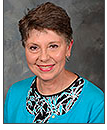 Union has been a leader in improving the academic achievement and graduation rates of our students. Part of that success is having children who are well fed and ready to learn. Being well fed also keeps kids healthy and cuts absenteeism so they spend more time at school. I have seen our students catch the enthusiasm of learning and be engaged in school when they know people care for them and want to help them get out of the poverty cycle by providing for some of their basic needs like nutritious food. There are people who say that what we are doing is taking over the responsibility of the parents. But until you can get the parents better paying jobs or the kids in better family situations, somebody has to feed these kids. We also have a lot of kids who are poor but not on a free program and don’t always have the money to pay. But we still feed them because it would affect their performance at school each day. We have to be the stopgap. Having a charge policy is not going to take care of their family’s economic problem. Many kids come from families with incomes so low the parents just cannot afford enough nutritious food for their children. I feel we should not neglect the basic needs of these children no matter what the status of the parents. When Dr. Dodd interviewed me for this job, she wanted to know what my basic philosophy was. I told her that my mission was to feed the kids great tasting, nutritious food without any discrimination regarding economic status. I feel our program is meeting that goal and is doing a lot of good. Some of our kids are getting three meals a day plus healthy snacks, which is what they need to develop physically and mentally and do well in school. We have breakfast in the class at all of our Title 1 schools and provide lunch with salad bars after the serving line where they can go up at any time and get as much fresh vegetables and fruits as they want. We also provide fresh fruit and vegetable snacks at all of our Title 1 schools through the USDA Fresh Fruit and Vegetable grant. As a result, our kids are eating fruits and vegetables galore,” states Mrs. Griffin.
Union has been a leader in improving the academic achievement and graduation rates of our students. Part of that success is having children who are well fed and ready to learn. Being well fed also keeps kids healthy and cuts absenteeism so they spend more time at school. I have seen our students catch the enthusiasm of learning and be engaged in school when they know people care for them and want to help them get out of the poverty cycle by providing for some of their basic needs like nutritious food. There are people who say that what we are doing is taking over the responsibility of the parents. But until you can get the parents better paying jobs or the kids in better family situations, somebody has to feed these kids. We also have a lot of kids who are poor but not on a free program and don’t always have the money to pay. But we still feed them because it would affect their performance at school each day. We have to be the stopgap. Having a charge policy is not going to take care of their family’s economic problem. Many kids come from families with incomes so low the parents just cannot afford enough nutritious food for their children. I feel we should not neglect the basic needs of these children no matter what the status of the parents. When Dr. Dodd interviewed me for this job, she wanted to know what my basic philosophy was. I told her that my mission was to feed the kids great tasting, nutritious food without any discrimination regarding economic status. I feel our program is meeting that goal and is doing a lot of good. Some of our kids are getting three meals a day plus healthy snacks, which is what they need to develop physically and mentally and do well in school. We have breakfast in the class at all of our Title 1 schools and provide lunch with salad bars after the serving line where they can go up at any time and get as much fresh vegetables and fruits as they want. We also provide fresh fruit and vegetable snacks at all of our Title 1 schools through the USDA Fresh Fruit and Vegetable grant. As a result, our kids are eating fruits and vegetables galore,” states Mrs. Griffin.


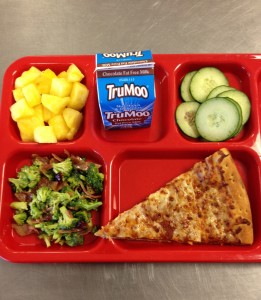
We have started serving supper meals for any after school activities going on at the schools. At the High School, many students stay after school for activities, such as sports or academics or clubs.
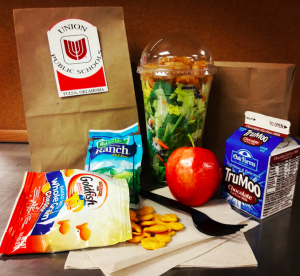
Coaches also shared with me that they were concerned about their students who were from poor families. The students may have jobs they have to go to or go home where there is no food before they come back for football practice. Many of these kids were hungry and could not make it through the practice. I took care of that need by starting a supper program with the coaches and their teams. Then I found out there were a lot of other activities going on in the evenings besides sports. Any student who is in these activities can eat supper at school. This year we also included 6/7 Grade and McAuliffe Elementary School on the Supper Meal Program.
The Supper Meal Program is funded through the Child and Adult Care Food Program (CACFP). If 50% of the students are on free or reduced meals at a school site, all the children can eat free. Students have an opportunity to eat a lot of good quality food and get everything they need in one day at the school. Our other schools still have snacks available in the evenings even if they don’t have supper.
We also work with the Food Bank and give out food bags and back packs for the weekend (Backpacks for Kids), a program I helped implement when I was with Tulsa Public Schools and then brought to Union.
Before school funding was cut, we had summer school at most of our elementary and secondary schools, and we fed kids breakfast and lunch at the schools during summer. Any child 18 years or younger can get free meals at the summer school sites. Last year, Union had to cut back to just three sites for summer school because of funding cuts. We knew ahead of time that with just the three sites there were going to be a lot of kids going hungry. We started contacting apartment complexes where the students lived. We asked the apartment managers to help by letting us use a room in their complex and by notifying parents of the free meals that would be available at their apartment complex. Working parents might not let their kids out of the apartment if they are by themselves, but despite this problem, we still reached quite a few last year and are planning to provide meals there again this summer.
Union Schools also have Supper Tuesdays during the summer when kids can come and use the library and media center, and we provide food for them on those days. These schools are all open sites and any child can come and eat. We also feed all the head start preschool kids during the summer.
About two thirds of our students participate in our nutrition programs because our food looks and tastes good. Knowing that the new federal regulations requiring lower sodium and lower fat would mean that the food would not be as appealing to students, we made plans to address this challenge. We hired chefs to help us with the preparation, seasoning, and cooking of food, and training of our employees. We serve as much fresh food as we can and buy locally grown foods from six farmers in the Tulsa area. We have also been able to get students to eat better foods through our nutrition education program. We have two dietitians who teach nutrition in the schools. They do not lecture but engage the students with hands-on activities and food tasting.
I also worked with the State Department of Education Child Nutrition Programs and Oklahoma State University to start a program called Cooking for Kids, which provides culinary training for any school in Oklahoma that is willing to attend training and be committed to change their foods. Chefs work with the kitchen staff at these schools on- site to learn new skills, prepare well-seasoned foods, conduct student tastings, cook more foods from scratch, and use more local foods.
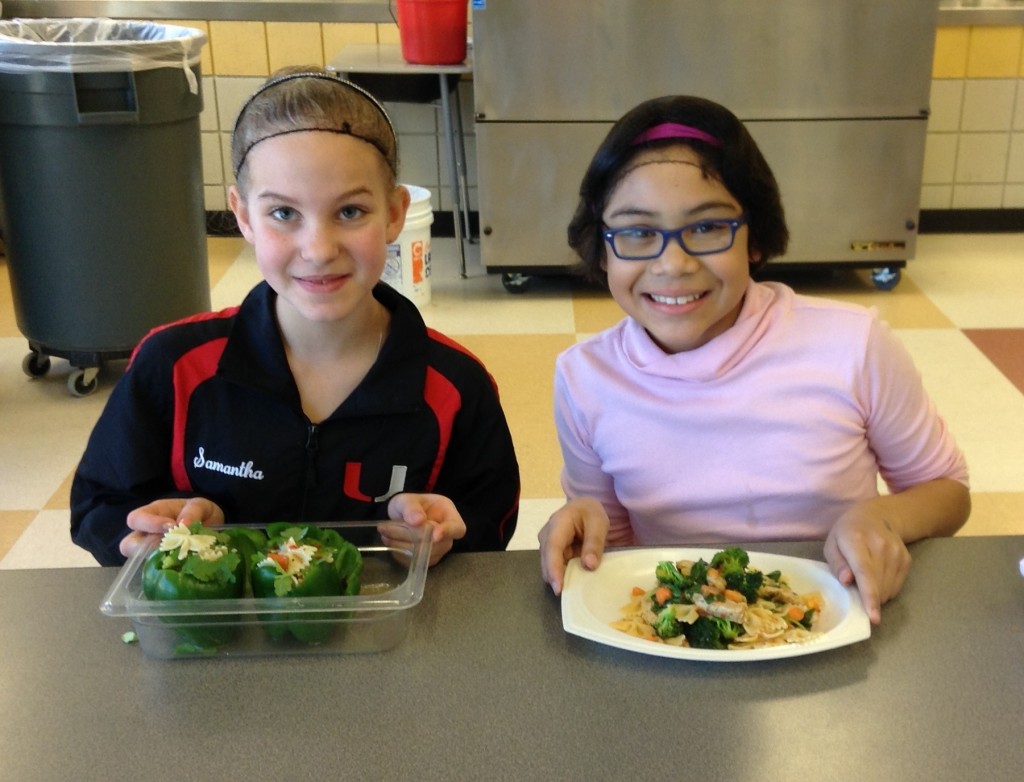
Food waste is a concern in school meal programs. Under the federal guidelines, every child is required to take a fruit or a vegetable. We did several plate waste studies at different schools and for different age groups. The older students eat more and do not throw away very much. We looked at the reasons students were throwing away food. We wanted to see if it was because the food did not look or taste good, and if that was the problem we corrected it. Sometimes there was a timing problem for the younger students when breakfast and lunch were just a couple hours apart, and they were not hungry yet. We also found there was peer pressure to take certain foods, which they eventually would not eat. Having recess before lunch reduced the amount of foods wasted. Short lunch periods that only allowed students to eat their foods in 7-10 minutes greatly increased the waste. We started a pilot recycling and composting program at McAuliffe Elementary School. Students leaders are responsible for sorting out waste, recyclables, and composting. Foods for composting are taken to a farm in North Tulsa and are composted, then brought back to the school to use in their garden. As part of the nutrition education program, the dietitians are explaining to students how waste is harmful in many ways, about the energy, time and money needed to produce food, and the effects of waste on the environment. We are trying to teach children to make conscious choices of foods that they will eat and not throw away. This helps us reduce waste and helps them become better consumers. We are also focusing on reducing waste in our kitchens during production of meals. Taking these steps has reduced our waste as well as our food costs.
Sometimes there is a stigma among students about who is getting free or reduced meals. I was able to address this problem when I developed the high school program. Our high school is called a collegiate academy, and I decided to present food concepts in a college atmosphere rather than an institutional environment where they all sit at long tables and all file in and can identify the kids on Title I. Instead we developed nine different places to eat in the building. Students can choose which food station they want. I first sought student feedback and suggestions to find out what kind of foods to offer and to see what they would name these concepts. For example, we have a place the students named the Street Market. We have two large woks that we cook Asian foods using fresh vegetables from local farmers. The aroma of the fresh food being cooked before their very eyes is very enticing to students. We also have a Hispanic food line. Many of the people working in the kitchen are Hispanic and know how to fix authentic Mexican foods. We encourage them to use their talents and skills to prepare foods students will enjoy. We also have a home-style station that we serve home-cooked meals such as chicken fried steak, mashed potatoes, green beans and a hot roll every Thursday. This is a very popular menu among students. We have an Italian food line that we serve homemade pasta and pizza every day. There is also a coffee bar, called the Cyber Café, with homemade whole grain pastries, muffins, sandwiches, wraps, homemade soups, smoothies, and specialty coffees, and we have a deli just like a Subway with three stations with made to order sandwiches, wraps, or salads. We also have a Panini bar and an energy snack bar, which is grab and go. All students, no matter what status they are-free/reduced/paid- can eat at any of the nine eating areas. This has reduced the stigma and discrimination.
Our employees and chefs assure that all of our foods taste and look good, and are served with great customer service. We cannot increase participation or compete with the fast food restaurants in the area if we don’t focus on high quality foods and service. High School students that are interested in culinary arts are given an opportunity to work in our kitchen with chefs who supervise and teach skills. There are also several culinary interns from Tulsa Tech and Okmulgee Tech culinary program that gain real life experience working in our kitchen. College dietetic interns are also offered learning experiences in our child nutrition program.
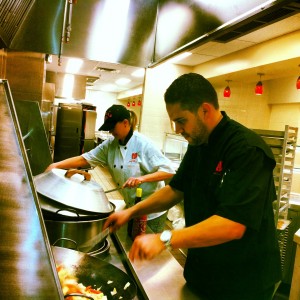
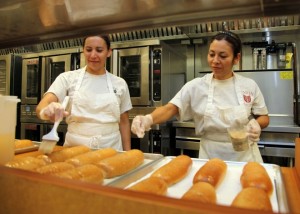
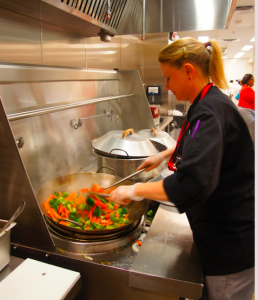
From the youngest to the oldest student, all are acquiring a taste for well-prepared foods. They are developing a palate for fine food that is prepared in our kitchens and come to expect it at all of our sites. That is why all schools are at the same high level of culinary skill and flavoring. At the high school, students’ trays are almost breaking due to so many fruits and vegetables on them. They learned to like these foods when they were younger and ate at our elementary schools. They eat things like kale, mushrooms, sweet potatoes and other good foods. When we started introducing a variety of fresh vegetables and entrees, there were people who said the kids were not going to eat these kinds of foods. Our response was we are introducing these foods to the students here at Union just like any other education program that provides knowledge and experiences to enhance the lives of our students. We were also successful because we watched the students’ reaction to what we were doing and got their feedback.
I have consulted in rural school districts’ child nutrition programs. There are many challenges in these schools including lack of funding to hire trained employees who know how to administer these programs and prepare the food. For example, rural schools may pay eight dollars an hour to the person who manages the cafeteria. It is very difficult to find anyone willing to work for that amount of money who has the knowledge or experience required to operate a school nutrition program. Also, people working in rural schools sometimes lack the knowledge of federal regulations, how to get funding for their school, and how to manage the finances/budgets. Food costs are much higher in smaller rural schools. Few vendors want to do business with a small, rural school and drop off a couple cases of food after traveling several miles to get there. A fuel surcharge is added to the cost of food, which increases the cost of foods. Schools like Union have much lower food costs because they buy in volume. For example, a carton of milk purchased by a large district will cost at least $.10 less than what it costs for a small school to purchase.
High food costs, low salaries, lack of knowledge about how to get funding from federal programs and how to manage the programs may mean these small rural schools are not able to provide students the same kind of quality nutrition program like Union. But there are things that can be done to improve the situation. Providing free, on-site “turn-key” training for these employees at rural schools would greatly help them. Lowering food costs may be possible by joining puchasing cooperatives. Assisting schools with their purchasing plan and practices may also help them find ways to lower costs and meet USDA regulations.
Improving the quality, flavor, appearance, and acceptance of food among students is another way to increase revenue by increasing student participation. Cooking for Kids, a program developed by the State Department of Education, Child Nutrition Programs and Oklahoma State University, is free and offers any school the opportunity to have chefs come to their schools ten times a year. This program is funded by a USDA grant. Chefs teach school child nutrition employees how to flavor foods, how to prepare foods for the best quality, taste, and appearance, how to market their foods, how to change the perception of their nutrition programs, and how to get students to eat more often in the school cafeteria. When child nutrition employees see students are happy about the food they serve, they become more engaged and are encouraged to make more improvements. I believe that as a state we need to take steps to extend and assist all of these different programs that the federal and state government offers to the rural school districts. We can also work to improve the food quality in all our school programs. That way more kids in Oklahoma will learn to eat fresh, nutritious food, will be healthier, and will achieve more academically.
Other Tulsa Nutrition Programs
The Community Eligibility Provision (CEP) is a way for many schools with a high poverty student populations to address these problems. It is an option that was developed for schools where more than forty percent of the students are certified. This means student are identified for free meals through means other than the school meal application. For example, they may qualify for the Supplemental Nutrition Assistance Program (SNAP) or Temporary Assistance for Needy Families (TANF).
CEP allows eligible schools to provide breakfast and lunch to all students at no charge without collecting school meal applications or monitoring eligibility for each student. Schools implementing CEP have experienced great success increasing student participation because all students eat at no charge. The schools do not have to keep track of each student’s account because they are reimbursed based on its identified student percentage (Total number of identified students divided by total).
 Kit Hines, the Director of Child Nutrition Services at Tulsa Public Schools and her team have enrolled all of the TPS elementary schools in CEP. All these schools qualify for CEP because 52.6 % of the elementary students are directly certified. 41 of the elementary schools are also enrolled in the Fresh Fruit and Vegetable Program (FFVP), where students get fresh fruit and vegetables samplings outside of breakfast and lunch meal service two to three days per week. The goal of the FFVP is to improve children’s overall diet and create healthier eating habits for their entire life by providing healthier food choices and expanding the variety of fruits and vegetables they experience.
Kit Hines, the Director of Child Nutrition Services at Tulsa Public Schools and her team have enrolled all of the TPS elementary schools in CEP. All these schools qualify for CEP because 52.6 % of the elementary students are directly certified. 41 of the elementary schools are also enrolled in the Fresh Fruit and Vegetable Program (FFVP), where students get fresh fruit and vegetables samplings outside of breakfast and lunch meal service two to three days per week. The goal of the FFVP is to improve children’s overall diet and create healthier eating habits for their entire life by providing healthier food choices and expanding the variety of fruits and vegetables they experience.
Tulsa Public Schools sponsors the Summer Café program that begins in June 1st and runs until August 4th. This is another federally funded program designed by the USDA to help low income children continue to receive nutritious meals free of charge during the summer. Tulsa Community Food Bank of Eastern Oklahoma is a partner in this program and provides feeding sites. The Food Bank had 13 sites for the 2016 TPS Summer Café Program.
As Dr. Block pointed out earlier, a child’s brain development continues from birth through adolescence. Good nutrition while children are growing is important all year long if they are going to reach their full potential. The Summer Café program provides healthy breakfasts and lunches free of charge to children up to eighteen years of age at seventy locations throughout the Tulsa area which includes schools, and other locations.
Only a fraction of children in need participate in the Summer Feeding Program. In the 2012- 2013 school year, 21 million children in the US were served free and reduced meals but only 3.5 million children participated in Summer Feeding Programs. Oklahoma ranks last in Summer Feeding participation. Eileen Bradshaw, the Executive Director of the Community Food Bank, gave some reasons for this. One is because the government requires the meals to be consumed on site. This means the kids need to make two trips per day to a site to access their meals. Parents may not be able to take them if they are working and parents may not want their children to make these trips by themselves. Secondly, Oklahoma is a rural state and distances for many children also make getting to these locations difficult. There are proposals to address both these transportation problems that we will explore later in this article.
Part 7: The Role of Food Banks in Combating Student Hunger
The Community Food Bank of Eastern Oklahoma is partnering with schools and developing innovative programs to address the problem of food insecurity facing students. Eileen Bradshaw is the Executive Director of this food bank and talks about particular programs they have developed with urban and rural school districts:
 Oklahoma’s schools are called on to do a lot to help address the problem of food insecurity among our students. Obviously the federal programs are very helpful. Tulsa Public School made a big leap this year invoking the Community Eligibility Clause for elementary students, which does not require each student to sign up. Instead all students are given free meals because of the high percentage of students who qualify. This was an important change that has allowed TPS to get more students to participate. It was often hard to get the kids to turn in their applications to get individual cards for the old food program in part because of the stigma of accepting free food. Now the students don’t have to carry a card and more are eating these meals.
Oklahoma’s schools are called on to do a lot to help address the problem of food insecurity among our students. Obviously the federal programs are very helpful. Tulsa Public School made a big leap this year invoking the Community Eligibility Clause for elementary students, which does not require each student to sign up. Instead all students are given free meals because of the high percentage of students who qualify. This was an important change that has allowed TPS to get more students to participate. It was often hard to get the kids to turn in their applications to get individual cards for the old food program in part because of the stigma of accepting free food. Now the students don’t have to carry a card and more are eating these meals.
We also know that while eating breakfast is important if students are going to learn, getting kids to school early to eat breakfast before classes start can be difficult. I have three children and I know how hard it can be getting kids to school early. The school buses often don’t get students to school in time to eat breakfast before their first class. We saw a lot of data that showed providing breakfast in the classrooms for those who could not get to school early had a positive effect. Dallas is one example of a school district where they saw an immediate 10% improvement in test scores when there were carts in the first period classrooms with breakfast. This program was offered to all students in the Dallas schools so there was no stigma for a student who was poor.
Food insecurity is a 24/7 problem that requires us to develop programs to get food into the students’ homes. One program we developed that has gotten a lot of exposure is our backpack program where we are getting food to a child who otherwise would not have access to food over the weekend. But this program does not necessarily ebb and flow like food insecurity does. Backpacks go out every weekend and the food in the backpacks must be uniform, shelf stable and single serve portions. It is an expensive method of service, but a good one for younger children. However, when kids get to middle and high school, they are mature enough come to a pantry in the school and select food for themselves and their families. It is efficient since the kids only go to the pantry when they need food in the household. This is our second years and we are in 14 high schools. The rate of uptake and methods vary significantly from school to school.
We see that most of the parents of kids on food assistance are working. Some parents are looking for work because they were laid off, or are not working due to illness or disability. The families of food insecure students do care about their children and want to take responsibility. They often just need help. These parents often sacrifice for their children., skipping meals so that their children may have food to eat. Oklahoma unfortunately has a lot of people working in low wage jobs. The state ranks only forty-first in average income per household compared to the rest of the country. If you work other than an 8 to 5 job it is difficult to get public transportation to work in Tulsa or anywhere else in Oklahoma, so most people must have a car to hold down a job. After you pay for housing, utilities and car expenses, there is just not a lot of room left for food especially for single parent households when average per capita income in Oklahoma is only around $25,000.
While participation in the federal programs that provide free breakfast and lunches is high and averages 56% across the state, some school systems are in areas where student enrollment in Title One programs is much higher. Enrollment at TPS is 86% using the lowest estimate I have compared to places like Jenks with 26% and Bixby with 18%. These were both small towns thirty years ago but as they grew some of the higher income population in Tulsa redistributed.
Student food insecurity is something that needs to be addressed even when school is out. Yet Oklahoma is dead last in the US in our summer feeding programs and solving this problem is complex. Some of it is due to transportation challenges. It is hard to get students to a feeding location in the summer. We have mobile trucks that go to specific locations every day. Some schools will open in the summer and help us serve meals. Parents and kids are comfortable there. But other schools don’t have the money to run the air conditioners and electricity in the summer. Manpower is also an issue. There has to be documentation for the government of how many people are there each day so somebody has to be at the school just for record keeping, and the current budget crisis makes paying summer help almost impossible. One superintendent I know is mowing the lawn himself because there are no funds.
The USDA has piloted a program in several locations using summer EBT cards. If you have a child eligible for free or reduced meals at school, during the summer months you would get $50 a month for each child on a declining cash card that is only good for food like the SNAP program. This has been successful in testing because it doesn’t require the same logistics as getting kids to sites where meals are served. It also eliminates transportation and safety concerns for working parents who may not want their older children going very far from home to get food.
Attendance in school is key to learning. But kids who are hungry get sick more and miss more days of school. My idea of a hungry child growing up was the one portrayed in the old CARE commercials where there were skinny, belly bloated children. Many of our food insecure kids in the US don’t fit that image. They are often are overweight because the food they can afford fills them up but doesn’t really have a lot of nutritional value. I try to shop at a store on SNAP days to see what people buy. A family of four may receive only $134.00 for the month. If you don’t have a lot of money, you will buy the things on sale, which are usually packaged foods. Seldom are fruits and vegetables on sale. We do have a great program in Oklahoma called Double Up Food Bucks, which allows people on SNAP who spend up to $20.00 on produce to receive a matching amount in produce from the Famer’s Market. We need more ways to get food insecure children in our state nutritional food because the health consequences of childhood food insecurity start early and are hard to reverse later on. Physical and intellectual development can be adversely affected by food insecurity. Diabetes and hypertension are becoming significant issues in children who do not have access to nutritious foods on a regular basis.
Our Food Bank gets donated food from a number of sources. We distribute food for the Federal Government under their agricultural programs. For example, if there is a bumper crop of cranberries, the government will buy up the surplus to keep prices stable, and we will get that fruit donated and distribute it. The same with dairy and other food covered under the price support program. Retail groceries have stepped up significantly in food donation. We receive shelf stable items such as canned and packaged foods from the manufacturers, and from local food drives. We also purchase food and try to do opportunity buys when food manufacturers might overproduce something. This overproduction was often donated in the past, but the manufacturers can now go to stores like the Dollar Tree and get paid something that will help them recoup their loss.
We always need manpower, transportation and donations of food and money to sustain our operations at the Community Food Bank of Eastern Oklahoma and welcome new volunteers.
Summary
The people we interviewed for this article have dedicated their lives to working with children and have shown us the kind of investments our state must make in our kids’ health and education if we want a workforce that will secure Oklahoma’s economic future. National studies have confirmed this clear relationship between a state’s investment in education and individual income. One comprehensive study was by the Economic Policy Institute and titled “ A Well Educated Workforce is Key to a State’s Prosperity” where EPI was able to demonstrate that a state’s economic success is tied to the level of investment in the health and education of their workforce.
Major findings of the EPI report include the following:
- Overwhelmingly, high-wage states are states with a well-educated workforce.
- Providing expanded access to high quality education will not only expand economic opportunity for residents, but also likely do more to strengthen the overall state’s economy than anything else a state government can do.
- Cutting taxes to capture private investment from other states has not been an effective economic development strategy because where it was tried the loss of revenue from these tax incentives undermined the state’s ability to invest in education.
- Investing in education is good for state budgets in the long run because workers with higher incomes contribute more through taxes over the course of their lifetimes.
It is important this kind of information stays in front of the public so the legislature can see that their current path is condemning Oklahoma to a future where we will have a much lower standard of living compared to other states. YPNG will be working to keep the importance of investing in our young people in front the Oklahoma’s legislature and the public that elects them. Please contact wclangdon@ypng.co if you would like to help us in this effort. We need people to produce public service announcements for radio and television and writers to submit articles to newspapers and the Oklahoma legislature.
Ten Policy Recommendations
.
Here are ten things we can do to see that all the kids in our state have the chance to succeed in school and in life. These recommendations are based on programs described in our interviews that have proven to be highly effective raising the level of academic achievement in local school districts. We have also seen that because we have so many low income families in Oklahoma, we will have to simultaneously address nutrition and pediatric care for these students if we are going to level the playing field and give all our young people the opportunity to achieve academically and develop their individual potential.
Policy Recommendation #1
Expand Community Schools In Low Income Areas
The CSC led the development of 18 community schools in low-income neighborhoods in the Tulsa area. OKC has also developed a community school in OKC. All have been successful in improving educational outcomes. Addressing the whole person by adding nutrition programs and giving students access to medical care in a school clinic combined with programs like Pre-K has proven to be a great equalizer for these low-income students. We believe this success shows the value in expanding the community school concept in neighborhoods and rural areas where low-income kids are concentrated. In many of these parts of Oklahoma, 85% to 100% do not get adequate pediatric care or enough nutritious food during the critical ages when their bodies and minds are rapidly developing. Community schools address these issues and give these kids a chance to break out of the cycle of poverty faced by most people living in these communities.
Policy Recommendation #2
Expand STEM Classes in Oklahoma’s Public Schools
The highest paying jobs in the future are expected to require degrees involving science, technology, engineering and mathematics. If we are going to be able to attract businesses with these kinds of jobs, Oklahoma schools must have more opportunities for kids to be exposed to STEM subjects as early as elementary. Union starts to offer their kids STEM classes in grade school and has opportunities for them all the way through high school. This is a good example of how STEM program can be organized in a larger school district. Tulsa Tech works with smaller schools to put STEM instructors in schools in their service area where there are not enough math and science teachers. They also offer transportation to their STEM academy for students attending one of the school districts they serve. But there is currently not enough money to for everyone who is qualified and wants to attend the Tulsa Tech programs. Using the state’s excellent technical school system to expand STEM instruction is a good a way to help more students take the classes they need to enter a college engineering program and is something that deserves to receive more funding.
Policy Recommendation #3
Restore Full Funding for Early Education Programs
Jan Figart talked about how Oklahoma had one of the best early education programs in the nation until recently when the budget cuts hit. Long-term studies prove that children taking Pre-K classes had better results throughout their academic careers. We know how to run effective Pre-K programs and need to have the legislature restore the budget for early education so we can expand them throughout the state.
Policy Recommendation #4
Expand Funding for the Oklahoma’s Technical Schools and Community Colleges
Oklahoma has the best technical school system of any state and is a model for the nation. But right now more high school students want to sign up for programs like the STEM Academy and health care programs like nursing than there are openings. Our state needs more engineers, nurses, radiologist and other medical professionals along with people in skilled trades. Our technical schools need more financial support so they can serve all the students who qualify for these programs.
Policy Recommendation #5
Continue to Develop Oklahoma’s Charter Schools
Although the Charter School concept has had mixed results across the state, about thirty percent of these schools perform at a higher level than public schools and several have developed innovative teaching methods that can be used to improve public school curriculums. Public charter schools also curriculums that developed to serve a particular group of kids like those wanting to prepare for college, a STEM career or those students who need a more structured learning environment. Since they are funded by the state on the same per pupil formula as other public schools, they do not represent a budget issue by themselves. But for Charters to be successful, they have to be able to hire experienced teachers because what drives innovation is teachers who develop their own curriculum based on their classroom experience. This means we have to increase the state’s education budget to be able to offer competitive salaries and benefits to charter school teachers just like we have to do for all our public schools if our public school system is going to be effective.
Policy Recommendation #6
Restore Funding for Higher Education
Oklahoma has been cutting funding for higher education at a time when we need more college graduates in our state. These graduates will be the drivers of the future Oklahoma economy. We should be making it easier for qualified kids to go to college not harder. Every state in the top ten in terms of individual income levels has a strong college system. Oklahoma needs to raise the additional money to restore funding that was lost by our public university system.
Policy Recommendation #7
Take Greater Advantage of Exiting Federal Nutrition Programs
We can also help poor children from going hungry by expanding the number of schools using the Community Eligibility Provisions under Title 1 to provide free breakfast and lunches to all the kids in a school when the percentage of Title 1 students is over 61%. CEP has the added benefit of getting more kids eating healthy because there is no stigma for Title 1 kids when everyone eats for free. The database of schools in Oklahoma eligible for CEP is on the Center for Budget and Policy Priorities webpage. You will see that very few schools in Oklahoma that qualify are taking advantage of this program. The same is true of the federal fresh fruit and vegetable program under the Department of Agriculture that Lisa Griffin and Kit Hines discussed in their interviews.
Policy Recommendation #8
Improve School Nutrition Services Throughout the State’s Public School System
Because good nutrition is important if kids are going to achieve academically, all schools throughout the state should train their food service staffs to develop healthy menus, purchase this food at the lowest cost and prepare the food so it tastes good. Lisa Griffin, the Director of Nutrition at Union, talked about how she introduced a variety of fruits and vegetable to her school menus and has been able to get the kids to eat these kinds of foods after developing their own recipes so the food tastes good. Serving high quality food and training people how to cook it should be done throughout the state. This will require a small budget for the state to hire people with culinary experience to teach school cooks how to season these nutritious meals without a lot of salt and sugar and for several nutritionists to be hired who can go into schools around the state and teach kids about the importance of healthy eating.
Policy Recommendation #9
Increase School Coordination with Food Banks
Helping students get access to nutritious food when they are not in school is also important if there is going to be continuity in their diets during the weekends and summer. The interviews with Eileen Bradshaw, Lisa Griffin and Kit Hines all give examples of ways the schools and food banks are working together to cover this void. Oklahoma food banks distribute food bags for hungry students and their families for evenings and weekends though these and several other schools. Some schools also open their buildings in the summer to help the food banks with summer feeding programs. But given the present budget cuts, many schools can no longer do this because they cannot afford to run the air conditioning or pay someone to supervise the food distribution of summer meals that could be provided at the school by the food bank and under federal programs. If all our public schools are adequately funded, than every school district will be able participate and all the food insecure kids in our state will have access to healthy food during the summer.
Policy Recommendation #10
Provide Access to Medial Care for Kids from Low Income Families
People who are associated with the OU medical center staff the clinics established in Union’s Community Schools. It is important that more schools work with the state and these kinds of medical providers to locate some of their community medical service programs directly in the buildings of schools in other low-income areas like they do at Union’s community schools and the Tulsa Dream Center. The improvement in these children’s ability to learn is now well documented and is a concept that should be expanded throughout the low-income school districts in our state.






